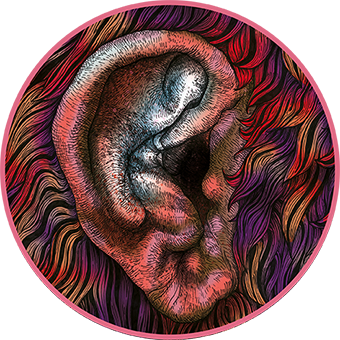* image: Lara Eggleton and David Steans. Produced for the exhibition 'As much about forgetting'.
Pattern interview 3
Lara Eggleton has been thinking and writing on ornament and artistic folly for quite some time. Her output moves between Art historian, creator of the folly matters blog, managing editor of Corridor 8 and visual artist. Lara was one half of the Medieval Helpdesk and is hopefully, enjoying doing it all from home just now.
PS : Our last Pattern interview closed with the idea that pattern touches primaeval chords within us that stretch across time and culture. I think that maybe has a nice loose link into some of the things you’ve mentioned about watching your son draw.
LE : I love watching my 2-year-old draw. We let him loose on a whiteboard and he works in an almost trance-like way to produce lines and shapes, sometimes joining them or repeating them, sometimes not. Watching him, it’s obvious how innate mark-making is, but also the repetitive motions and gestures that produce pattern. He’s still at a stage where he isn’t always trying to represent things, and I try to describe his lines in abstract terms so as not to falsely attribute meaning to them. We are all patterners to begin with; it’s only Western art that historically privileges representation and naturalism.
Kids’ drawings are a great reminder of how universal abstraction is, how we are all born knowing how to do it (or at least how to read it – infants love to ‘trip out’ on black and white graphics).
PS : How we project onto it and receive from it, that’s one of the great focal points of the Medieval Helpdesk project, right?
LE : Medieval helpdesk has been going since 2015, buoyed up by invitations to collaborate on a weirdly predictable annual basis. After our last collaboration (part of a group exhibition, Ecstatic Rituals, at Humber Street Gallery last year) we decided to bring it to an end, to make time for our respective practices. Medieval helpdesk evolved out of our shared interest in how the ‘dark ages’ occupies such a prominent place in popular culture and collective imagination, and the ways it operates a productive foil for our experiences as humans today. Revisiting and re-creating the medieval allows us to play out contemporary struggles around the sacred and profane, of suffering and death, and so on – things that people in the so-called ‘developed’ world are increasingly distanced or alienated from.
In 2018 David and I travelled to Viborg in Denmark for an exhibition called ‘As much about forgetting’ to perform a piece. I was dressed as a pig (a costumed nod to the hogback gravestone) and we were having a conversation where I struggled to remember my medieval origins. Hogback gravestones are found only in Britain (mainly Yorkshire and Scotland) and hail from a time when Viking culture was overlaid on Saxon, so it’s very specific but also difficult to decode. They incorporate pagan and Scandinavian symbols and are unique to that time and place of colonisation and occupation. There are various myths and associations ascribed to them, such as the ‘berserker’ bear, which are largely speculative, and I’m attracted to that margin of interpretation. We also liked the idea of poking fun at the authoritative scholar (played by David in our performance), who is bent on nailing down the facts when history is, in fact, a foggy, nebulous terrain where ‘facts’ take on their own creative currency.
PS : I guess ornament should be quite successful at holding cultural identity and evoking it again but I like your implication that decorative systems' capacity for storage is somehow very leaky. That feels very true to me. I think sometimes the leakiness is part of the freedom offered by pattern and ornament. Do you know what I mean?
Nasrid Palaces, the Alhambra. By Ronny Siegel - Own work, CC BY-SA 4.0, Link
image: www.alhambragranada.org
LE : ‘Leaky’ is a good word for it. Ornament is a kind of language that is both specific to a culture or individual but more often than not contains shared grammar and syntax. The cross-fertilisation of motifs is something I became really interested in when I was studying the Alhambra (an Islamic fortress-palace in present-day Granada, Spain), as so much of its patterned surfaces contain clues about the overlapping religions and cultural identities of its eras - plural because it also became a Christian site after its conquest in 1492. The mashup of styles, symbols, ornamental languages and mythologies is staggering and continues to open up new questions about how people embraced, rejected, assimilated or subverted existing styles to create new ones. I think there is both diffusion and loss through this process, sometimes quite purposefully when some elements are traded or retained to signal a shift in power or a new period of reign. The absenting or erasure of certain decorative elements is often the most telling.
LE : Owen Jones, a Victorian designer obsessed with geometric pattern (he wrote The Grammar of Ornament, now famous as a coffee table book but quite revolutionary in its archiving of global pattern making, from Greek entablatures to Maori tattoos), was really interested in this idea of flatness. He championed what he called a ‘naturalised bloom’ in patterns which eased the eye and brought on a pleasing meditative state, an effect that he saw Islamic artisans as having mastered. But you’re right, this flattening can also be homogenising, and many of his patterns did exactly this – chopped and changed elements from wildly different cultural contexts, merged and fixed them together, and then machine-produced them as wallpapers. They were very eclectic (and very modern looking, ahead of their time) but also empty or blank somehow.
Owen Jones - Scanned from a reprint of Jones’ book by Aristeas., Public Domain, Link
Owen Jones - Scanned from a reprint of Jones’ book by Aristeas. Public Domain, Link
PS : I got a copy of that book after our first chat; it’s packed with fragments from these incredible far-flung sites. One of the amazing things he does there is trace tendencies and forms through different cultures. It’s interesting that his own designs are eclectic but blank because one of his strongest messages in the book is that the original blossom of invention of a culture is its peak, and it's all downhill from there, ha. It's a very big picture, essentialist vibe.
Although Chinoiserie is really interesting - apart from anything else it’s now a nostalgic part of British culture. Bamboo wallpaper permeates from perhaps the 1700s to Delboy's flat in Only Fools and Horses right through to Farrow and Ball's current range. I find that kind of cultural aspiration exciting and funny.
LE : There’s no better betrayer of aspiration than appropriation! Whenever I see a William Morris knock-off on someone’s feature wall I am amazed at how timeless and versatile his patterns are. They signify quality, beauty, wealth, taste, internationalism and artisanal craft, a kind of uber-symbol of aspirational wealth and status. It’s interesting to see how a Morris design travels across time and context, compared to say, the bamboo pattern. What is it about those particular patterns – their style, cultural import, or whatever – that grant them access to particular stylistic modes and social strata? It can tell us a lot about how cultures are viewed and valued from the perspective of others.
PS : That’s very interesting, I wish it was something I understood better. I guess information is often held in there by the objects’ social lives. Whether it’s ritualising a space like a creating a gravesite, or pinning a picture to a fridge, there’s always this social ornamentation of cultural goings-on, however loose, centred around objects?
575 Wandsworth Rd.
Patrick Baty, historical paint consultant. www.patrickbaty.co.uk
575 Wandsworth Rd.
Patrick Baty, historical paint consultant. www.patrickbaty.co.uk
LE : Yes, I think there’s something about the unconscious or semi-conscious creation of pattern in the home (love the fridge analogy), that reconfigures and refreshes meaning. This idea of a living pattern in everyday spaces is wonderfully embodied in Khadambi Asalache and Susie Thompson’s house in Lambeth, and there are other examples that date back much further (take the 18th and 19th century grotto or shell house – the world of folly making is full of such accretions). The gradual building up and arranging of ornamental features is like a moving diorama of meaning, placed in domestic spaces where it can be contemplated and further augmented.
PS : On that note how are you getting on with lockdown.
LE : Lurchingly. Some days I feel completely flat and helpless, others super energised… it’s confusing. At least I’m not hungry or miserable without (or with) company though. You?
PS : Oh, I don’t know. Fine I think, I’ve mostly reverted to an old brain setting from a residency, so things don’t feel too weird. It takes a lot of effort to keep order to the place though, mess wise and mentally.

